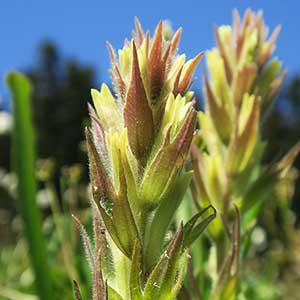Castilleja nelsonii
Castilleja cryptantha
Arizona or southern mountains paintbrush, Rincon Mountain Indian paintbrush
Mt. Rainier or obscure paintbrush, obscure Indian paintbrush, obscure paintbrush
few to many, ascending to erect, unbranched or often strongly and diffusely branched distally, hairs sparse to dense, spreading to matted, long proximally on stem, becoming puberulent distally, ± stiff, eglandular, often mixed with retrorse shorter ones.
few to several, erect or ascending, unbranched, hairs spreading, long, soft, eglandular, mixed with short stipitate-glandular ones.
green, linear-lanceolate or narrowly to broadly lanceolate, 2–6.5(–8) cm, not fleshy, margins plane, flat to involute, 0(–3)-lobed, apex acute;
lobes ascending, lanceolate, apex acute to obtuse.
green, often with brown or purple veins, narrowly to broadly lanceolate, 1.5–4 cm, not fleshy, margins plane, ± involute, 0–3-lobed, apex acute to acuminate;
lobes spreading-ascending, narrowly lanceolate, apex acute to ± obtuse.
(2.5–)5–15 × 2–4.5 cm;
bracts proximally greenish, distally scarlet to red or orange-red, rarely yellow or crimson, veins usually yellow or yellow-green, contrasting conspicuously with base color, lanceolate or elliptic to oblanceolate or obovate, 0–3(–5)-lobed;
lobes ascending, lanceolate to triangular, medium length, arising above mid length, apex rounded to obtuse.
(2.5–)3–6 × 1–2 cm; green to dull brown or dull reddish purple throughout, or proximally green to dull brown or dull reddish purple, distally yellow on apices, broadly lanceolate to ovate, (0–)3-lobed;
lobes ascending, narrowly lanceolate, long or short, arising near mid length, apex acute or acuminate.
slightly curved, 15–35 mm, subequal to calyx or beak partially to strongly exserted;
tube 15–17 mm;
beak adaxially yellowish green, 10–16 mm;
abaxial lip green, reduced, ± pouched, 0.5–1.5 mm, 4–10% as long as beak;
teeth incurved, deep green, 0.7–1 mm.
straight, 14–16 mm;
tube 11–14 mm;
whole corolla included within calyx;
beak adaxially pale yellow, 1–2 mm;
abaxial lip deep green, slightly inflated, 4–5 mm, 67% as long as beak;
teeth ascending, pale, 1.5–2 mm.
mostly yellowish throughout, with a thin reddish apex, 15–27 mm;
abaxial clefts (5–)9–11 mm, adaxial 4.5–9.5 mm, clefts 25–50% of calyx length, deeper than laterals, lateral 2–4 mm, 10–20% of calyx length;
lobes linear-lanceolate to triangular, apex acute to acuminate, rarely ± obtuse.
proximally green or pale with green veins, lobes yellow, sometimes becoming deep red with age, 12–15 mm;
abaxial and adaxial clefts 3–7 mm, 25–50% of calyx length, deeper than laterals, lateral 1–3(–4) mm, 8–20% of calyx length;
lobes triangular, adaxial segments longer than abaxials, apex acute or obtuse.
= 24.
= 24.
Castilleja nelsonii
Castilleja cryptantha
Castilleja nelsonii is fairly common in the upper elevations of the so-called sky island ranges from central and eastern Arizona to adjacent New Mexico, southward into the Sierra Madre Occidental, at least as far south as southern Chihuahua, where the type collection was obtained on Cerro Mohinora. Although it was long known in the United States as C. austromontana, the name C. nelsonii has priority. Some specimens from southern Coconino County, Arizona, approach C. miniata, but most material is easily separable. Castilleja nelsonii occasionally hybridizes with C. mogollonica in Apache County, Arizona, near the border of the range of the former.
(Discussion copyrighted by Flora of North America; reprinted with permission.)
Castilleja cryptantha is endemic to the vicinity of Mt. Rainier in the Cascade Range, with most populations found within Mt. Rainier National Park. Unlike most species of Castilleja, it is apparently self-pollinating (W. J. Duffield 1972); the small flowers are entirely enclosed within the yellowish calyces, which tend to grow deep reddish as they age. The purplish brown bracts are also unusual in the genus.
(Discussion copyrighted by Flora of North America; reprinted with permission.)


